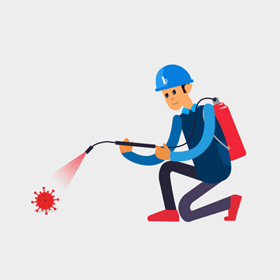

Office sanitizing is a critical practice aimed at maintaining a clean and healthy workspace by eliminating harmful microorganisms and preventing the spread of infectious diseases. This process involves thorough cleaning and disinfection of surfaces, equipment, and common areas within an office environment. The goal is to create a hygienic atmosphere that safeguards the well-being of employees and visitors.
One of the primary reasons for office sanitizing is to mitigate the risk of illness transmission. Offices are communal spaces where individuals from diverse backgrounds converge, bringing with them various germs and bacteria. Regular sanitizing routines help curb the potential spread of viruses and bacteria, such as the common cold or influenza, which can thrive on surfaces like desks, doorknobs, and shared equipment.
The process of office sanitizing typically begins with routine cleaning, where dust and debris are removed from surfaces. This initial step is crucial as it prepares the environment for the subsequent disinfection process. Disinfectants, which may come in the form of sprays, wipes, or cleaning solutions, are then applied to surfaces to kill or inhibit the growth of microorganisms. Areas with high human contact, such as light switches, elevator buttons, and communal kitchen spaces, require special attention during this phase.
In addition to protecting the health of individuals, office sanitizing contributes to the overall productivity and morale of the workforce. A clean and sanitized workplace fosters a positive and comfortable atmosphere, reducing the likelihood of absenteeism due to illness. Employees are more likely to feel valued and supported when they perceive that their employer prioritizes their well-being by maintaining a sanitary environment.
The ongoing COVID-19 pandemic has further underscored the importance of office sanitizing. Employers are now implementing enhanced cleaning protocols to address the heightened concerns related to the transmission of the virus. Common touchpoints, such as handrails, bathroom fixtures, and shared electronic devices, receive increased attention to minimize the risk of contamination.
Moreover, office sanitizing aligns with regulatory guidelines and industry standards. Health and safety regulations often require businesses to implement measures that promote a clean and hazard-free workplace. Compliance with these standards not only avoids legal repercussions but also demonstrates a commitment to the health and safety of everyone within the office setting.
Technology and innovation play a crucial role in modern office sanitizing practices. Automated cleaning devices, ultraviolet (UV) light technology, and antimicrobial coatings are examples of advancements that enhance the effectiveness and efficiency of the sanitization process. These innovations not only streamline the cleaning process but also contribute to sustainability by reducing the need for excessive chemical usage.
In conclusion, office sanitizing is a multifaceted approach that encompasses cleaning and disinfection to create a safe and healthy work environment. Beyond its immediate benefits in preventing the spread of illnesses, it positively influences workplace culture, compliance with regulations, and embraces technological advancements for optimal results. Prioritizing office sanitizing is an investment in the well-being of employees and the overall success of any organization.
Please reach out if you have any questions or need further clarification.
Copyright 2013 Orbit pest control inc.. all right reserved - Site developed by StarWebies.